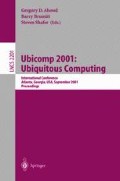Abstract
This paper tries to serve as an introductory reading to privacy issues in the field of ubiquitous computing. It develops six principles for guiding system design, based on a set of fair information practices common in most privacy legislation in use today: notice, choice and consent, proximity and locality, anonymity and pseudonymity, security, and access and recourse. A brief look at the history of privacy protection, its legal status, and its expected utility is provided as a background.
Access this chapter
Tax calculation will be finalised at checkout
Purchases are for personal use only
Preview
Unable to display preview. Download preview PDF.
References
59th Conference of Privacy-Commissioners in Germany. Data Warehouse, Data Mining und Datenschutz. See HTML version of the resolution passed at http://www.datenschutz-berlin.de/doc/de/konf/59/datawa.htm, March 2000.
Gregory D. Abowd and Elizabeth D. Mynatt. Charting past, present and future research in ubiquitous computing. ACM Transactions on Computer-Human Interaction, Special issue on HCI in the new Millenium, 7(1):29–58, March 2000.
Philip E. Agre and Marc Rotenberg, editors. Technology and Privacy: The New Landscape. The MIT Press, 1998.
Helmut Baeumler, editor. E-Privacy. Vieweg Verlag, Braunschweig, Germany, 2000.
Victoria Bellotti and A. Sellen. Design for privacy in ubiquitous computing environments. In Proc. of the European Conference on Computer-Supported Cooperative Work, 1993.
Oliver Berthold and Hannes Federrath. Identitaetsmanagement. In Baeumler [4], pages 189–204.
David Brin.The Transparent Society. Perseus Books, Reading MA, 1998.
Business Week/Harris Poll. A growing threat. Business Week, March 2000.
Peter Cochrane. Privacy. Sovereign, May 1999.
Lorrie Cranor, Marc Langheinrich, Massimo Marchiori, and Joseph Reagle. The platform for privacy preferences 1.0 (p3p1.0) specification. W3C Candidate Recommendation, HTML Version at http://www.w3.org/TR/P3P/, December 2000.
Lorrie Faith Cranor, Joseph Reagle, and Mark S. Ackerman. Beyond concern: Understanding net users' attitudes about online privacy. Technical Report TR 99.4.3, AT&T Labs-Research, April 1999.
Mike Esler, Jeffrey Hightower, Tom Anderson, and Gaetano Borriello. Next century challenges: Data-centric networking for invisible computing. In Proceedings of MobiCom'99, Seattle, 1999.
Amitai Etzioni. The Limits of Privacy. Basic Books, New York NY, 1999.
European Commission. Directive 95/46/ec of the european parliament and of the council of 24 october 1995 on the protection of individuals with regard to the processing of personal data and on the free movement of such data, November 1995.
Robert Gellman. Does privacy law work? In Agre and Rotenberg [3], chapter 7, pages 193–218.
Ruediger Grimm, Nils Loehndorf, and Philip Scholz. Datenschutz in Telediensten (DASIT). DuD-Datenschutz und Datensicherheit, 23(5):272–276, 1999.
Harris Interactive. IBM multi-national consumer privacy survey, October 1999.
Marit Koehntopp and Andreas Pfitzmann. Datenschutz next generation. In Baeumler [4], pages 316–322.
Lawrence Lessig. Code and other Laws of Cyberspace. Basic Books, New York NY, 1999.
James Michael. Privacy and Human Rights: An International and Comparative Study, With Special Reference to Developments in Information Technology. Dartmouth Pub Co. / UNESCO, 1994.
E. Mynatt, M. Back, R. Want, M. Baer, and J. Ellis. Designing audio aura. In Proceedings of the ACM Conference on Human Factors in Computing Systems (CHI'98), Los Angeles, CA, April 1998.
Organisation for Economic Co-operation and Development (OECD). Recommendation of the council concerning guidelines governing the protection of privacy and transborder flows of personal data, September 1980.
Andreas Pfitzmann and Marit Koehntopp. Anonymity, unobservability, and pseudonymity — a proposal for terminology. In Hannes Federrath, editor, Proceedings Workshop on Design Issues in Anonymity and Unobservability, volume LNCS 2009. Springer Verlag, 2001.
US Department of Commerce. Safe harbor website. http://www.export.gov/safeharbor/.
Samuel Warren and Louis Brandeis. The right to privacy. Harvard Law Review, 4:193–220, 1890.
Alan F. Westin. Privacy and Freedom. Atheneum, New York NY, 1967.
William Pitt, Earl of Chatam (1708–1778). Speech on the excise bill.
Author information
Authors and Affiliations
Editor information
Editors and Affiliations
Rights and permissions
Copyright information
© 2001 Springer-Verlag Berlin Heidelberg
About this paper
Cite this paper
Langheinrich, M. (2001). Privacy by Design — Principles of Privacy-Aware Ubiquitous Systems. In: Abowd, G.D., Brumitt, B., Shafer, S. (eds) Ubicomp 2001: Ubiquitous Computing. UbiComp 2001. Lecture Notes in Computer Science, vol 2201. Springer, Berlin, Heidelberg. https://doi.org/10.1007/3-540-45427-6_23
Download citation
DOI: https://doi.org/10.1007/3-540-45427-6_23
Published:
Publisher Name: Springer, Berlin, Heidelberg
Print ISBN: 978-3-540-42614-1
Online ISBN: 978-3-540-45427-4
eBook Packages: Springer Book Archive

